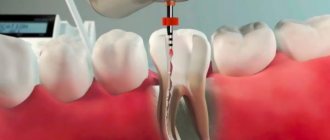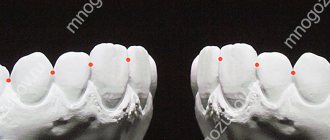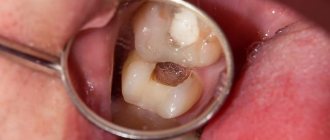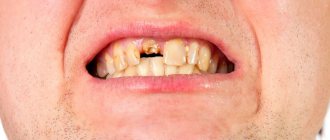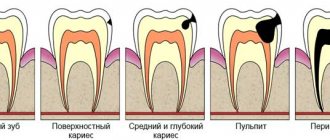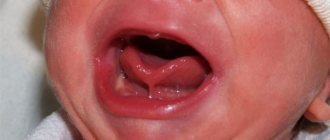Untimely treatment of caries in children leads to the development of pulpitis - inflammation of tooth tissue, including blood vessels and nerve bundles. The lower molars are most often affected, but the disease occurs even on the anterior elements. Therefore, pulpitis in children occurs even more often than in adults. This is due to a number of factors:
- thin weak enamel;
- large volume of pulp;
- wide root canals;
- less mineralization;
- weak immunity.
In addition to caries, pulpitis can be caused by trauma, including poor treatment.
Symptoms
Inflammation occurs in acute and chronic forms. Acute occurs less frequently, but has more severe symptoms and occurs in two stages:
- serous. The inflamed pulp is filled with serous fluid. There are complaints of severe pain in the tooth, intensifying at night and when chewing. The pain, as a rule, is intermittent, appears once and subsides. Most often, the process occurs in teeth with unformed or absorbable roots. After 5–6 hours, a transition to another stage occurs;
- purulent. Pus forms in the tissues, which begins to melt cells and tissues. The severity of the condition is influenced by immunity, dental condition, and bacterial activity. If the pus has an outlet in the form of a carious cavity or fistula, then the pain is mild. In the absence of outflow, the pain syndrome is bright and long-lasting, intensifying when chewing or eating cold or hot food. The general condition may worsen and fever may appear.
Chronic pulpitis occurs after acute pulpitis or on its own and is characterized by vague symptoms. Pain can only occur under unfavorable factors - cold or hot, too sweet food. The child begins to chew on one side, an unpleasant odor appears, and a bursting and pressing sensation occurs.
The danger of this form is that it is almost asymptomatic. Because of this, inflammation affects more and more tissues. Chronic pulpitis is of three types:
- fibrous. The lightest and most common form. Fibrous tissue grows, the pulp may bleed, and episodic pain appears from mechanical and thermal contact;
- hypertrophic. Develops with severe destruction of the tooth crown. Pathological growth of pulp tissue occurs, which fills the carious cavity;
- gangrenous. The most severe form, accompanied by pulp necrosis. The tooth becomes gray and bad breath appears due to tissue decomposition.
Classification of childhood pulpitis
Acute pulpitis comes in two subtypes:
- focal pulpitis (partial);
- diffuse pulpitis (general).
Chronic pulpitis has more varieties:
- Gangrenous pulpitis
This form of pulpitis is a direct consequence of an acute diffuse inflammatory process that developed from a focal one. The tooth enamel noticeably darkens, but no pain is observed. During the examination, the doctor reveals a characteristic putrefactive odor, which indicates the presence of a pathogenic process. A fistula forms at the top of the gum next to the damaged tooth.
- Fibrous pulpitis
This subtype is characterized by periodic aching pain that occurs during eating and continues after completion.
- Hypertrophic pulpitis
The main signs of this type of pulpitis are: destruction of the tooth crown, absence of pain (maximum discomfort during chewing). Pain occurs during probing of the tooth and when exposed to various irritants (temperature, chemical, mechanical).
How to recognize the problem and is emergency treatment required?
Due to the reduced sensitivity of the pulp, pain during inflammation may be mild and not cause severe discomfort. In this case, the process of tissue destruction occurs rapidly. It is important to visit the dentist regularly and not ignore your child’s complaints of pain when chewing or when eating cold and hot foods.
Treatment for pulpitis should be immediate. The disease is dangerous due to complications - periodontitis or periostitis. It can also spread to a permanent tooth that has not yet erupted and destroy it.
Treatment methods
The treatment of primary teeth in general does not differ from the treatment of permanent elements. If the child’s condition is serious, there is a threat of infection spreading throughout the body, amputation is performed. In most cases, the tooth is preserved to prevent malocclusion. Therapy is carried out in different ways:
- traditional. Involves treatment in three visits. During the first one, the nerve is opened, a devitalizing paste with arsenic is applied for 24-48 hours or without it for a period of up to 7 days. On the second visit, a pulp mummification mixture based on resorcinol-formalin is placed into the canals. At the last visit, a permanent filling is installed;
- modern. It takes place in 1 – 2 visits. If the child can sit quietly for a long time at the doctor and the roots of the tooth are formed, extraction is performed. The nerve is removed either on the first visit or after applying the paste. Next, the canals are carefully processed, infected tissue is removed, an anti-inflammatory paste (for example, zinc eugenol) is applied and closed with a filling. The composition will gradually dissolve along with the roots when changing teeth;
- partial vital amputation. The doctor removes the upper portion of the nerve and applies an antiseptic and anti-inflammatory medication that seals the remaining living pulp.
When treating teeth with immature roots, a different approach is chosen. This is due to several reasons:
- the apex of the roots has not yet closed and there is a risk of infection of the permanent tooth germ;
- the roots are short and the channels are wide;
- trauma to the upper zone of the root can lead to disturbances in its formation;
- It is impossible to remove the entire pulp and perform a complete canal treatment.
Most often, they choose amputation of the pulp by any method or biological treatment, when the tooth is cleaned of the affected tissue and a paste with calcium hydroxide is applied for several days. After this, a filling is installed.
General overview
Chronic hypertrophic pulpitis, which in dentistry is also defined as a pulp polyp, is an inflammatory process that forms in the structure of the dental pulp and is accompanied by proliferation. The pathology is characterized by two forms, the first of which is granulating - when the tissue located inside the pulp chamber gradually grows into the carious cavity. The second form is the formation of a pulp polyp, with the formation of gingival epithelium on the surface of the pulp.
Is it possible not to treat pulpitis if the teeth are baby?
There is a common opinion that it is not necessary to treat baby teeth, because they will soon fall out. This is the biggest mistake parents make. Untreated pulpitis leads to irreparable consequences and even affects permanent teeth:
- purulent abscess, periodontitis, life-threatening condition;
- deep infection affecting the germ of a permanent tooth;
- malocclusion due to early tooth extraction due to untimely treatment;
- pain interferes with normal chewing of food, uneven load on the teeth leads to accelerated destruction of other elements.
Prevention
The main method of preventing dental and oral diseases is regular visits to the dentist and treatment of caries in the early stages. It is important to teach a child hygiene and the rules of brushing teeth from the first years of life. Parents should control the diet, which should contain all the necessary substances, limit sweets and allow only water to drink at night.
Doctors at the VIMONTALE clinic treat pulpitis of primary teeth in children of any age. Specialists not only master modern painless techniques, but also know how to find contact with a child, know how to reduce anxiety and win the favor of the youngest patients.
Expert of the article you are reading:
Lozinskaya Alla Nikolaevna
Pediatric dentist, general dentist.
You may also be interested in:
Children's orthodontist Dental treatment for children Correction of bite in children Features of the treatment of childhood caries Removal of baby teeth Prevention of childhood caries Silvering of teeth in children
Show more
Features of the treatment of pulpitis in children
During the treatment of children's teeth, not only the nature of the pathological process and the speed of its development are taken into account, but also the timing of the formation of the roots of permanent teeth, as well as the resorption of milk roots. As a rule, the root system of replacement teeth grows completely by 3-4 years. In permanent teeth, it ceases to form only several (4 - 5) years after eruption. But these times are average. In fact, the formation of roots is possible both earlier and later than these numbers. Frequent infections and chronic diseases, pathologies of the endocrine system, and injuries during childbirth especially postpone this process to a later date. In some children, the roots of permanent teeth are finally formed at 5 - 6, and even 7 years after eruption.
Based on the timing of formation and resorption of the root system of teeth, removal of primary molars is possible at 8–9 years of age. This allows you to avoid the development of complications that may arise in the periapical area due to the application of arsenic paste.
In incisors, pulpitis is rare, but due to the small size of the soft tissues of the tooth, it quickly turns into chronic periodontitis.
When choosing a treatment method for pulpitis in children, the anatomical features of the tooth for each specific age are taken into account. The effectiveness and safety of treatment, as well as the speed of spread of inflammation, depend on this. It is also important to clarify the condition and degree of development of the root canals, evaluate the teeth in general and health, as well as the psychological readiness of the child for treatment. If there is an insurmountable panic fear of the dental chair, it is possible to treat the child’s pulpitis under sedation.
Our patients
Patient recommendations
Akhmedkhanov Said Rashidovich
Dental surgeon, general dentist, implantologist, orthopedic dentist, dental therapist.
Make an appointment 8 (499) 520-98-70
Make an appointment
Recommendations from patient Alekseeva O.V.
Akhmedkhanov Said Rashidovich
Dental surgeon, general dentist, implantologist, orthopedic dentist, dental therapist.
Make an appointment 8 (499) 520-98-70
Make an appointment
Recommendations from patient Zolotareva S.V.
Akhmedkhanov Said Rashidovich
Dental surgeon, general dentist, implantologist, orthopedic dentist, dental therapist.
Make an appointment 8 (499) 520-98-70
Make an appointment
Recommendations from patient Vera
Akhmedkhanov Said Rashidovich
Dental surgeon, general dentist, implantologist, orthopedic dentist, dental therapist.
Make an appointment 8 (499) 520-98-70
Make an appointment
Recommendations from patient Mikhail Ivanovich
Akhmedkhanov Said Rashidovich
Dental surgeon, general dentist, implantologist, orthopedic dentist, dental therapist.
Make an appointment 8 (499) 520-98-70
Make an appointment
Collapse


